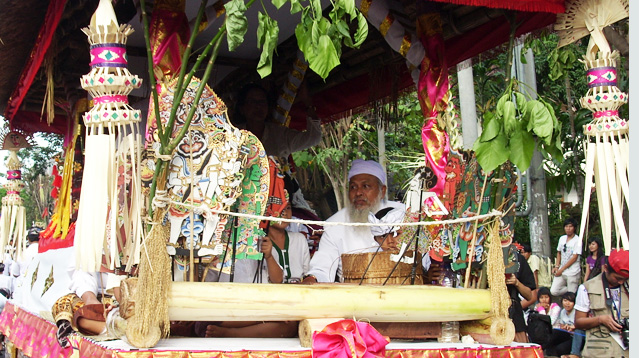- SHADOW puppet for Hinduism in Bali does not only serve as entertainment but also functions to complete ritual procession
- Wayang Lemah as part of the shadow puppet can also be functioned for exorcise human impurity
Wayang or shadow puppet performance in the tradition of Balinese Hindu community is not only intended for entertainment, but also related to the rituals in the five sacrifices or Panca Yadnya (Dewa, Manusha, Rishi, Pitra and Bhuta Yajna).
Well, the shadow puppet related to the Manusha Yadnya can also be performed at the exorcism ritual. Those who were born in the wuku wayang or other wukus (in the Balinese pawukon calendar) require a ruwatan or exorcism ceremony accompanied with a special wayang lemah.
As the name suggests, the Wayang Lemah (in Balinese, lemah means ‘day time’), this shadow puppet is performed during day time so that the performance is very simple because there is no need to use screens, blencong light and without any other supporting facilities.
This sort of shadow puppet emphasizes on the magical side of the religion to treat people born on the day of wuku wayang because they are believed to be under the threat from Bhatara Kala. The sanctified things are the storyline played along with the accompanying offerings, not the wayang figure or the characters.
The puppeteer rests the puppets on a white tukelan thread (the result of traditional spinning) along of the screen size and tied to eryhtrina sticks attached to a banana stem on both sides of the puppeteer. At each end of the thread is suspended a series of perforated coins (200 pieces) or some people are optionally using 11 pieces of perforated coins.
When holding performances, the puppeteer is usually supported by only one or two pairs of gender gamelan players. Because it is related to rituals, the performance stage is made at the ritual location. After the show is over, the exorcism participants and their families receive holy water from the puppeteer. After that, it is resumed with the peak of the exorcism ceremony.
Despite its simple appearance, the wayang lemah show has several functions, namely religious functions, the media of disseminating Itihasa (Ramayana or Mahabharata epic) messages consisting of theology, heroism, ethical-moral education, purification or exorcism. The story is packaged in such a way in accordance with the duration of the ceremony.
Wayang lemah commonly tells the story about the birth of Bhatara Kala and Rare Kumara as children of Lord Shiva. Bhatara Kala, who was born by a mother in the form of a fish, wanted to claim Lord Shiva’s promise that he could prey on people born on the day of Tumpek Wayang coinciding with his birth. Coincidentally, his younger brother named Rare Kumara was also born on the same day. As promised, Lord Shiva allowed Bhatara Kala to prey on Rare Kumara, but after growing adult. Actually, this is just a ploy to keep Rare Kumara away from Bhatara Kala’s threat. In order to save him, Rare Kumara was ordered to come down to earth, but was still being chased after by Bhatara Kala. One day, he arrived at a shadow puppet show.
In order to avoid Bhatara Kala, the puppeteer told Rare Kumara to hide in a bamboo resonance tube of gender gamelan. Due to feeling hungry and thirsty after chasing Rare Kumara, Bhatara Kala devoured the offerings of puppeteer. Ultimately, he forgot the original goal.
Because of the dalang’s offerings and services, Rare Kumara could be saved. This story inspired the concept that those who were born on the day of Tumpek Wayang had to organize wayang lemah exorcism in order to avoid from being preyed by Bhatara Kala.











